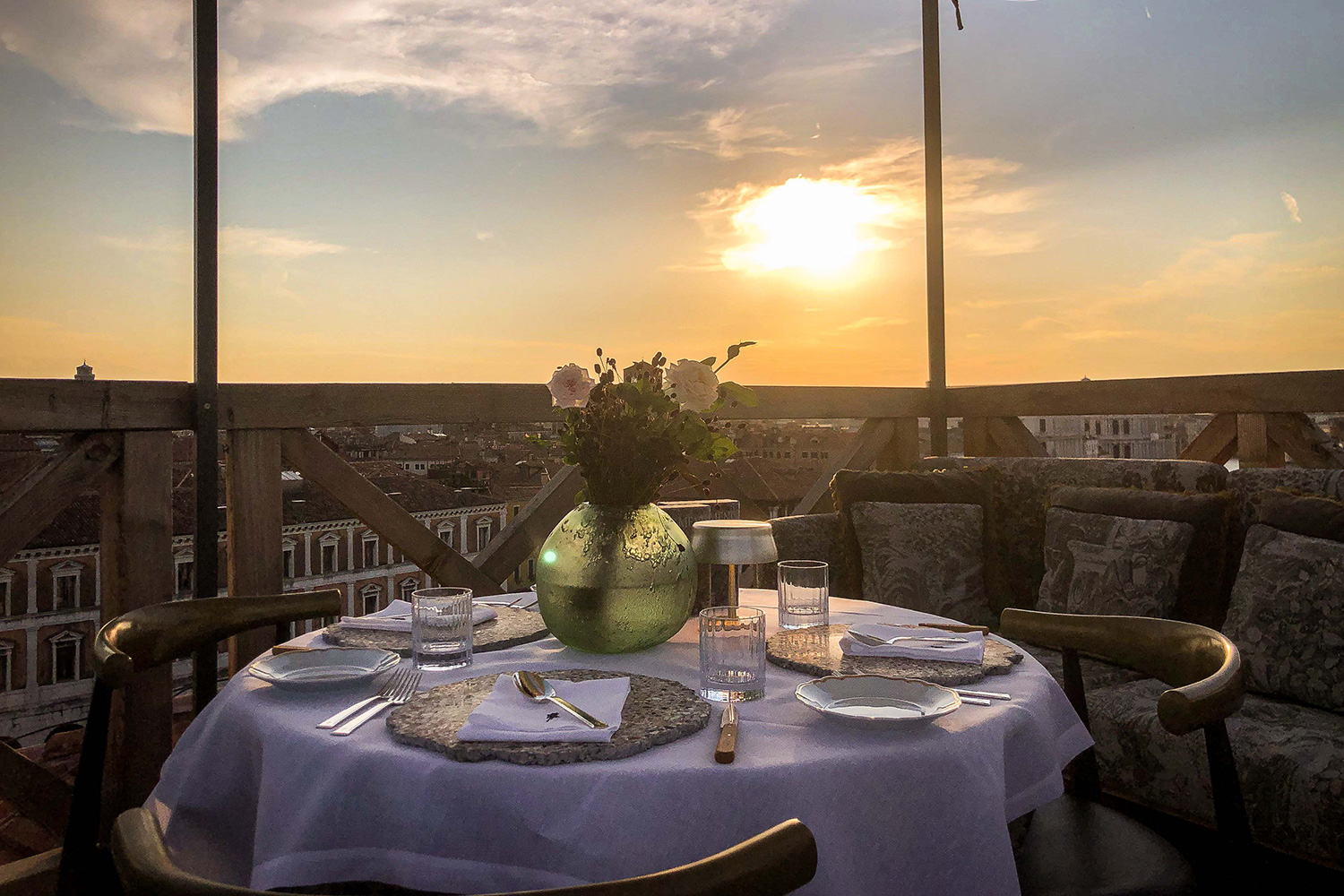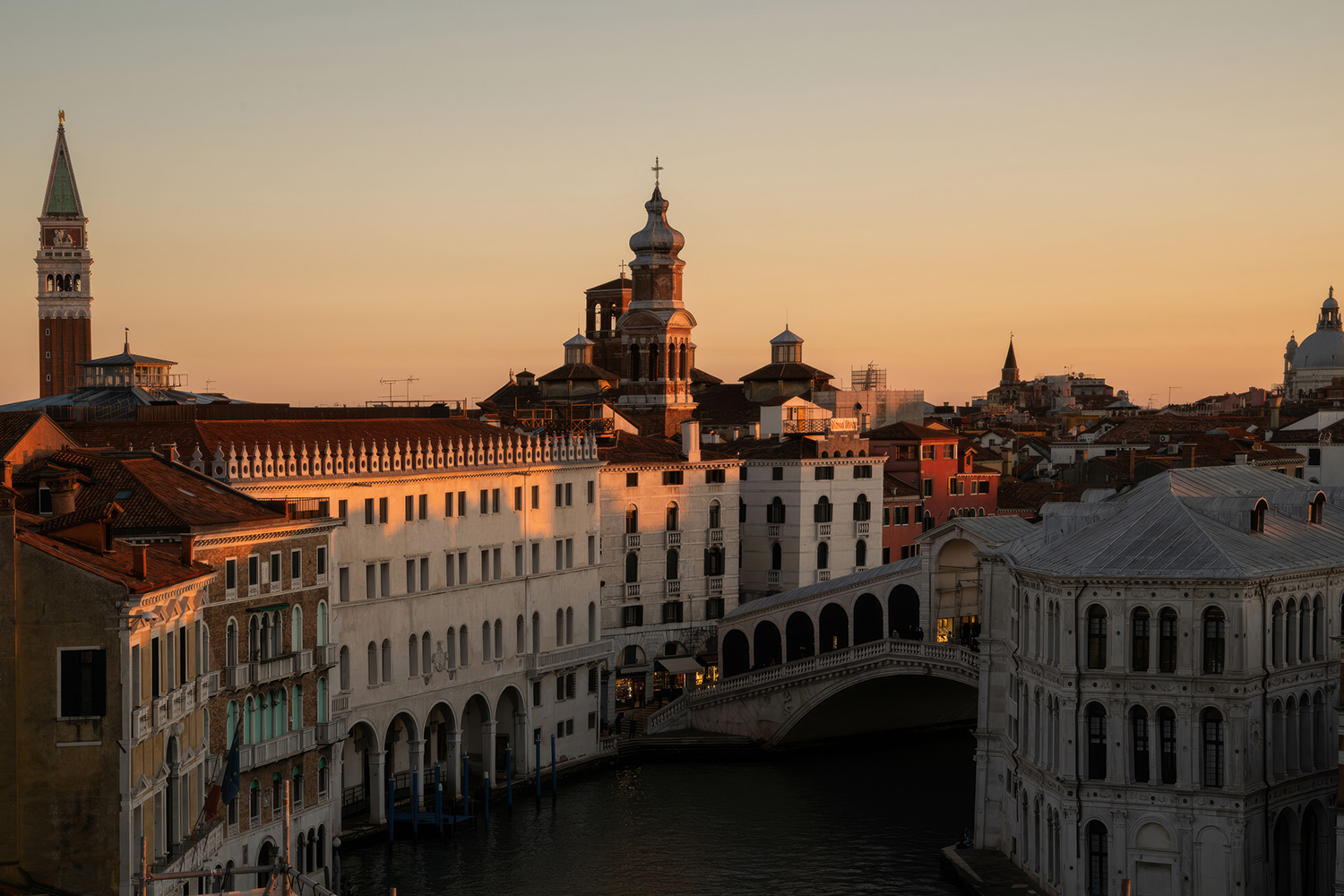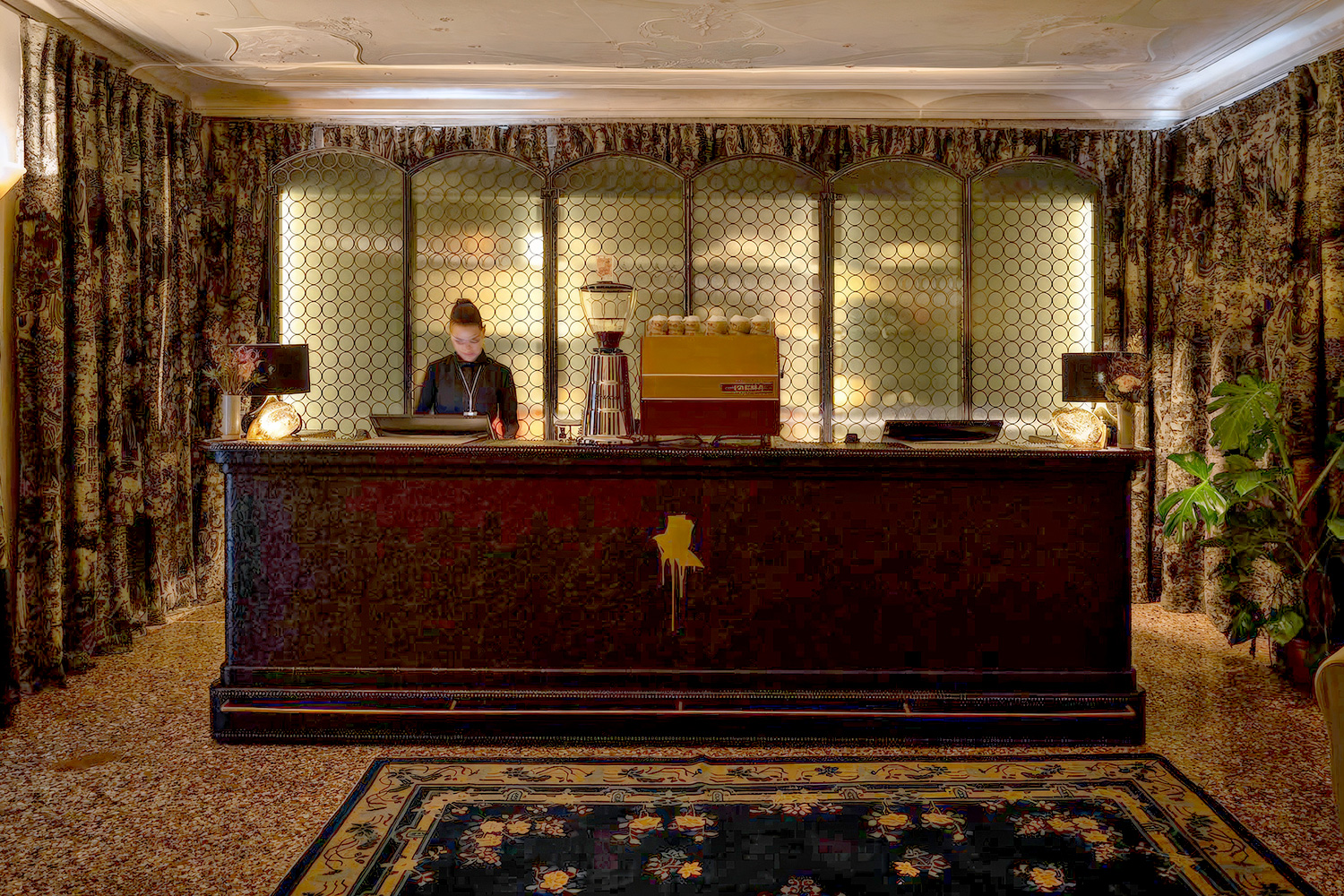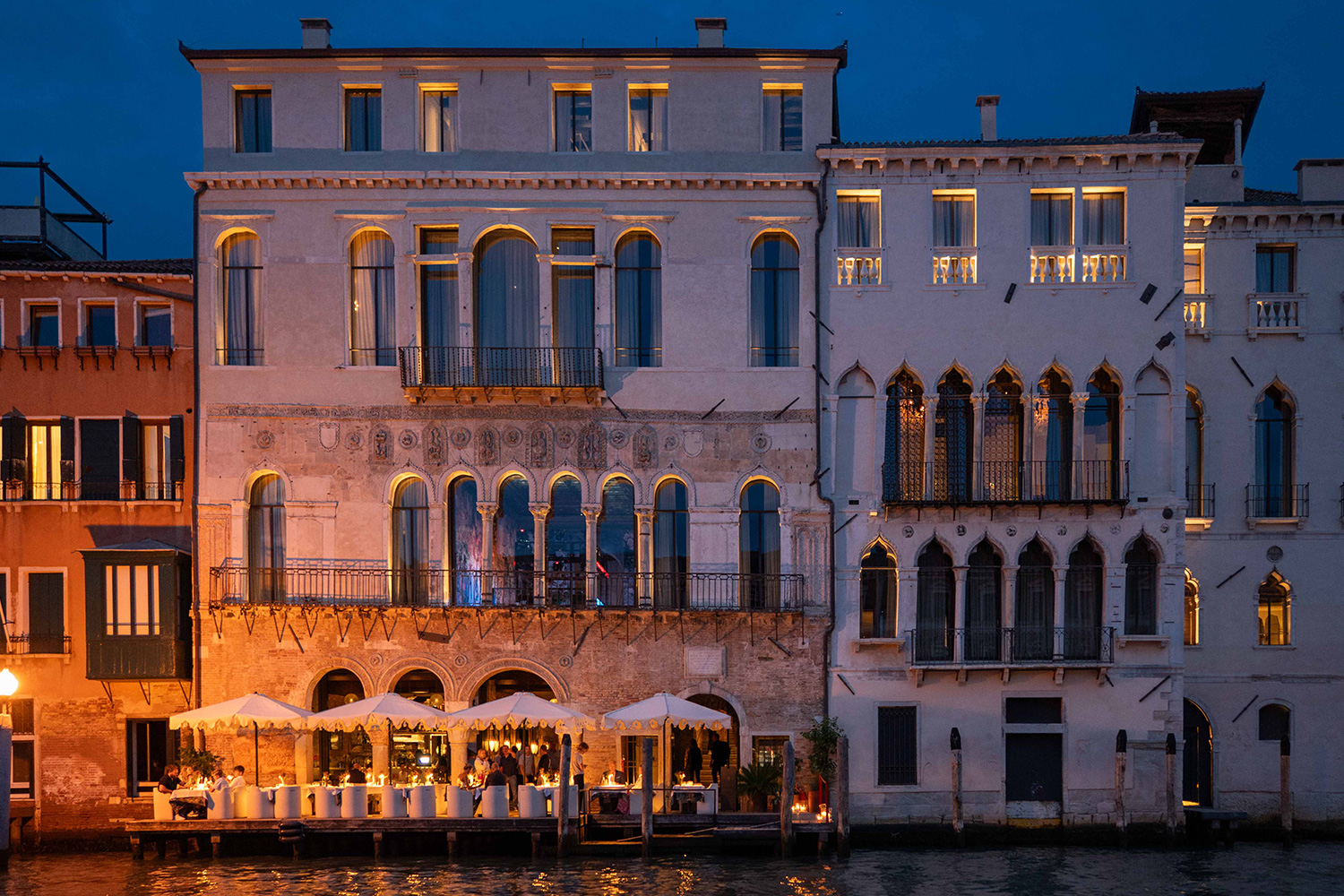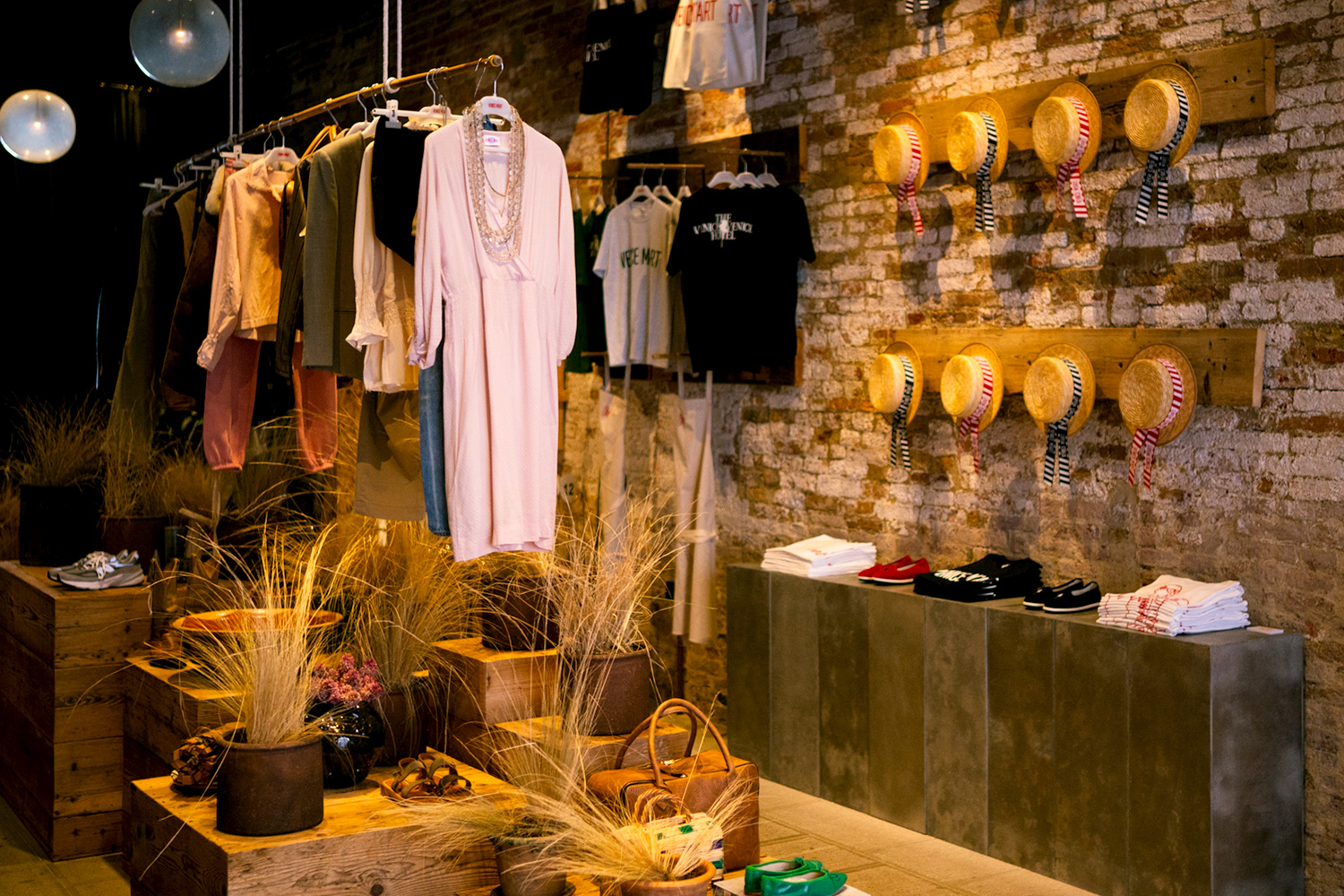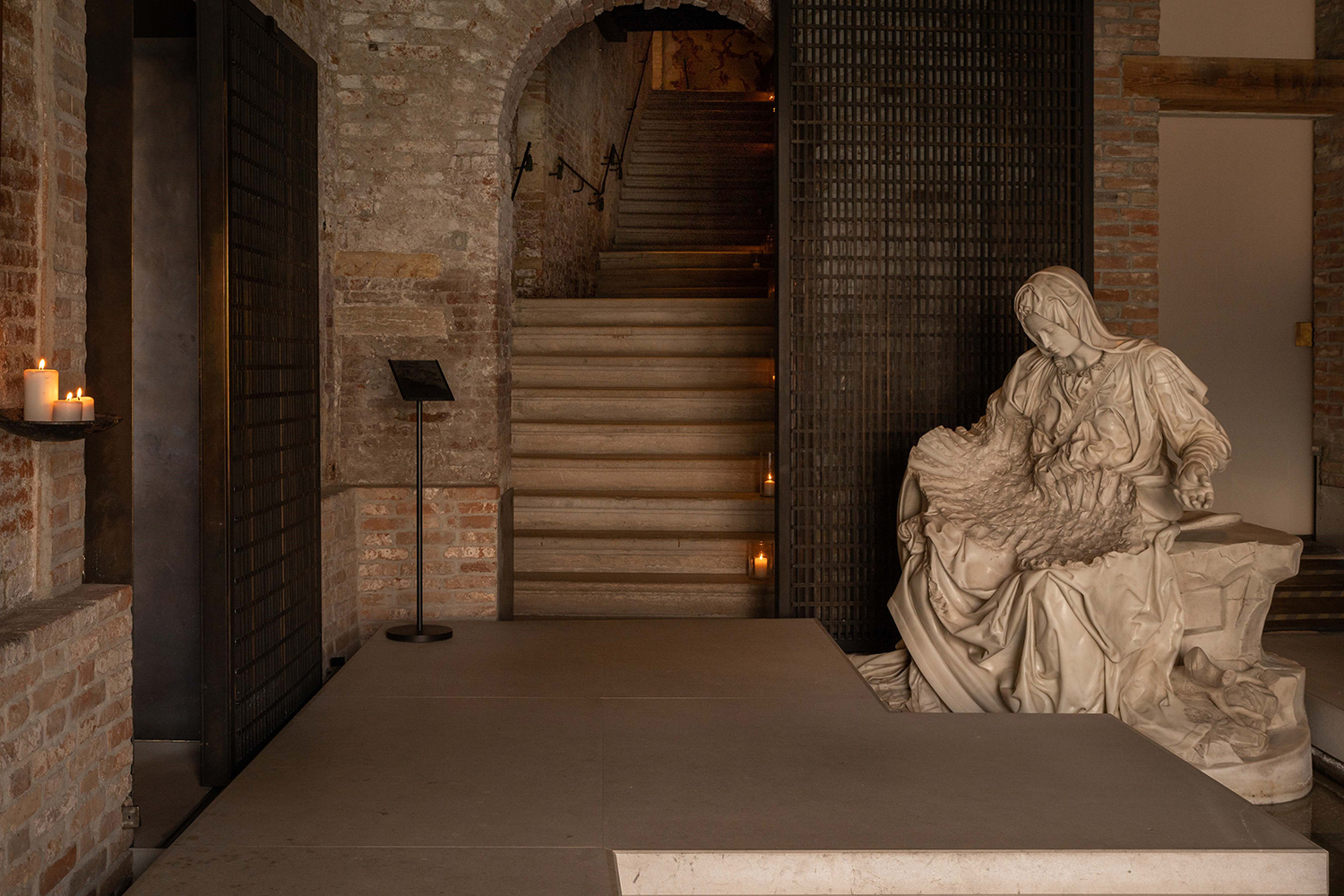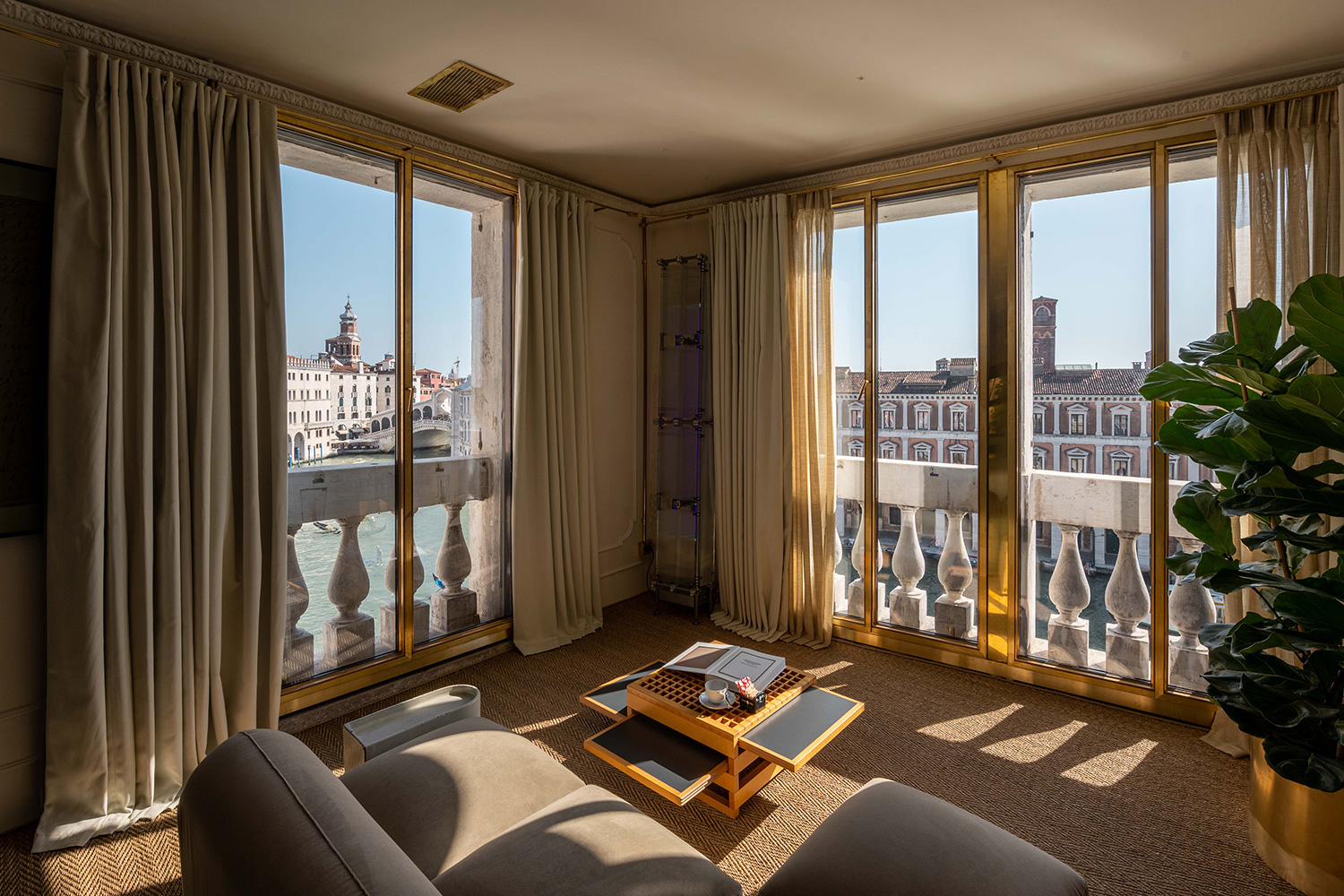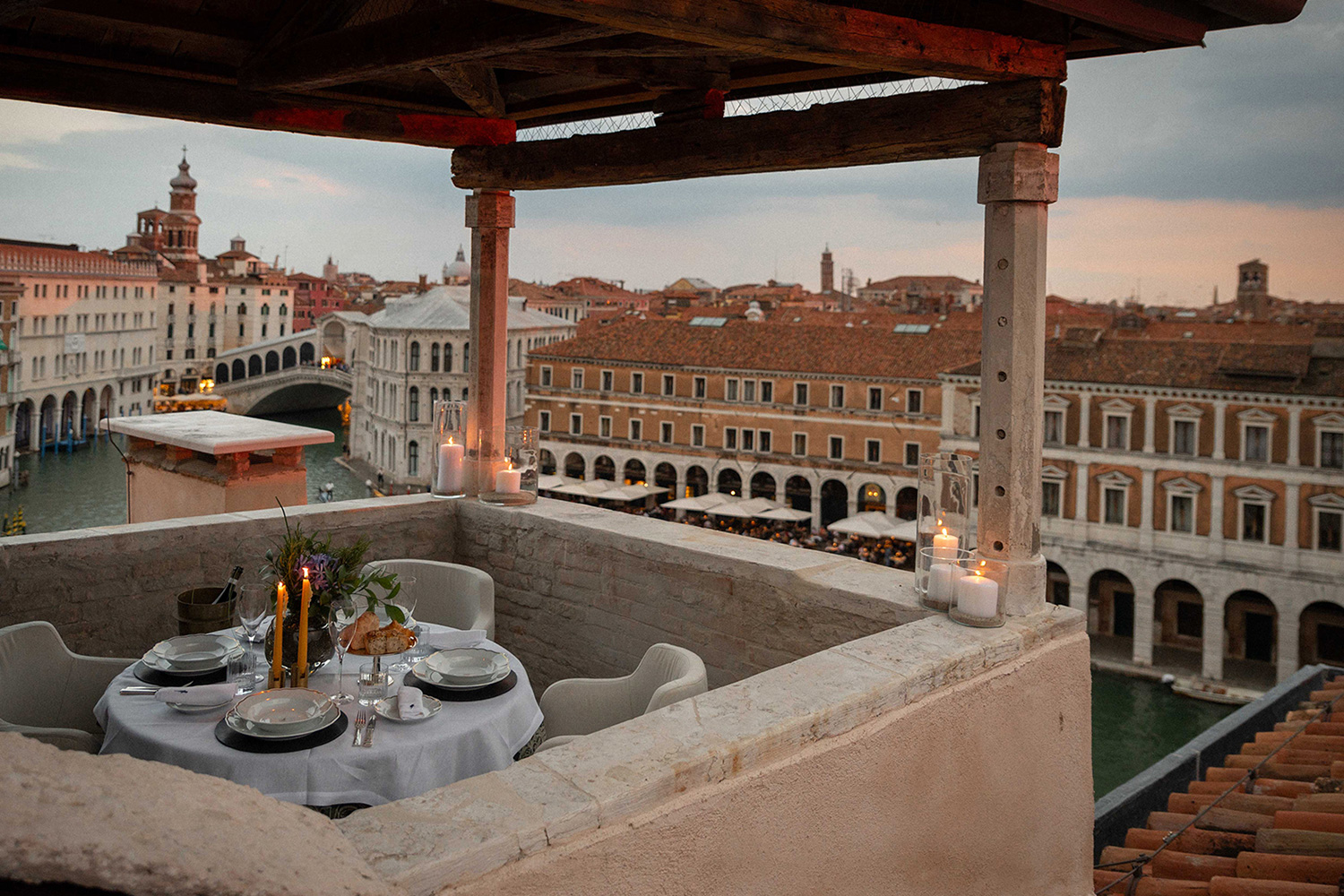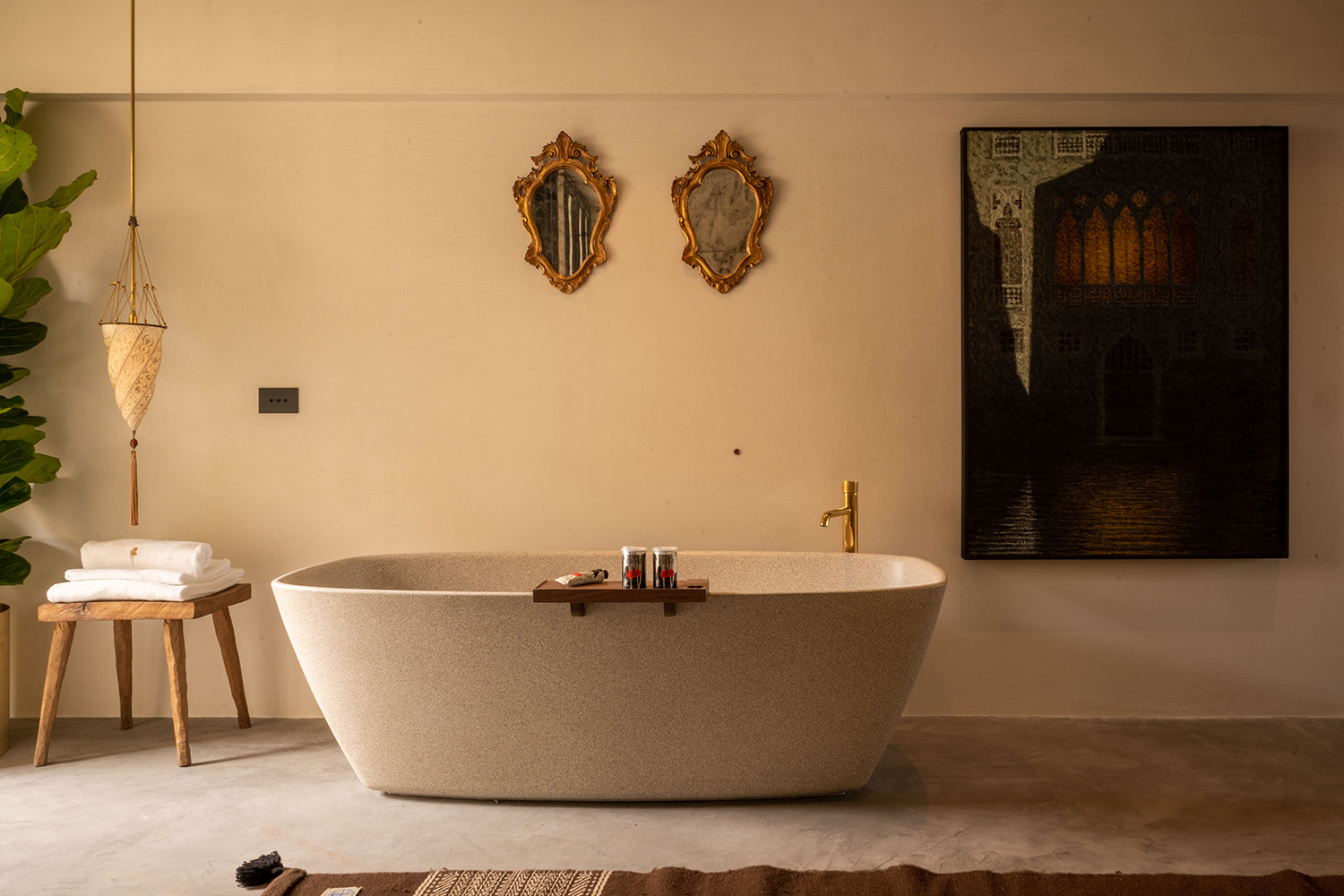意大利威尼斯威尼斯酒店
The Venice Venice Hotel
venicevenice.com
雨不慌不忙地下着,滴落在威尼斯大运河的水面上无痕无响,两侧的宫殿教堂等古老的建筑随船荡漾后去。即将入夜的水之城在一片昏蓝中亮起星星灯火,暖意的光揉进黛蓝的河,摇曳出一幅大画;摇曳着,直到最终的靠岸......
上岸之地是2022年开业的威尼斯威尼斯酒店,毗邻著名的里亚托桥和老市场。
酒店由著名的达莫斯托宫殿Palazzo Ca‘da Mosto改造而来,以历史为基绽放新生,独特的命名来自酒店对自身建筑历史的自信,以及“后威尼斯”风格Postvenetian的开创性定位。
一座建筑的生命能否永恒?这里就是答案。
作为大运河上最古老的建筑,威尼斯威尼斯酒店的前身达莫斯托宫殿Palazzo Ca‘ da Mosto始建于13世纪,是昔日威尼斯在拜占庭帝国影响下的时代写照,更是如今威尼斯重点保护的古建之一。
达莫斯托宫殿最初由巴罗齐Barocci家族所有,此家族是威尼斯城最早的创始家族之一;之后由达莫斯托家族的马可・达莫斯托Marco da Mosto购得,自此建筑冠以了家族的名号。在无数岁月中,建筑前的渡口成为其家族专属,甚至写进了法律。
最使此建筑声名卓著的是其在17到19世纪期间的风采。在这二百年间,达莫斯托宫殿作为“白狮酒店Albergo Leon Bianco”华丽转身。当欧洲的状游之风逐渐开启,带动欧洲无数的富豪名人来到威尼斯探源历史与艺术,享乐生活,白狮酒店是当仁不让的中心,吸引贵族政商作家诗人,甚至沙皇和神圣罗马帝国皇帝来此下榻,独领风骚。
当世人想起威尼斯,隐形的历史和传统之墙仿佛只将这座古城限制在了过去,而酒店意在面向未来,首创“后威尼斯”风格定位,在传统威尼斯美学的基调上铺开前卫的对抗的恒变的艺术概念,展示威尼斯更多的可能性。
步入酒店正门,一个两侧有曲迂水池的灰暗空间显露在前,白色大理石的圣母和圣子雕像分置呼应,一扇仿佛闸口的铸铁网格门立在不远,那里是通向二楼前台的幽幽石阶。根据威尼斯传统,以前这处空间是行船直入的船库,优雅的改造给宾客营造了入住前的“开胃菜”。二楼前台墙壁上框住一张大幅英文纸张,不怎么平整的纸面上随性写着:“艺术即简单(Art is easy)”。
酒店标志是一支正在滴下颜料的黑色玫瑰,一种不同于传统却根于过往的爱与美在整座酒店穿梭,曲折蜿蜒的空间布局源于古老的建筑形式,斑驳肌理的墙壁映衬明暗闪动的灯光,不时就会有种穿越欧洲古堡的奇特氛围感。
在临水的一层,一处长条形的大空间贯穿自运河河岸直到酒店后院,想必曾是贵族们举行舞会宴请的场地。如今,靠近河边的是临水餐厅,波光跳动在拜占庭风格的柱子上;入里为室内用餐区,举行活动时,摇身一变为烛火跳耀的隆盛晚宴,或响彻长厅的爵士音乐现场。直达后庭的部分是Venice M‘ Art精品店,商品灵感来自建筑本身,以及建筑周围熙攘市场的余韵。
威尼斯威尼斯酒店的每间客房都具有自身的独特性,这来自于古宅的构造,也来自于设计师和艺术家的装点。
名为“威尼斯遗产Venetian Heritage”的51号套房,主空间的窗前可见左右而去的运河水路伴着无数建筑远去,里亚托桥近在眼前;画有威尼斯全景的古老巨幅地图横挂在墙面,而房间的墙面竟都保有几百年前的湿壁画遗存。避免了补彩重修,壁画只做了足够的保护层,那些或暗淡或残缺的颜料和笔触正是可见可触的威尼斯历史。
客房内的所有家具陈设都来自定制,处处展露独特设计;艺术品源于私藏和精选,而房中许多他处难觅的器具用品铺盖等等都能在酒店的精品店中购得。特定的客房还配有土耳其浴室和小型健身房,十分全面。
一条近四公里长的大运河,倒S型的河道贯穿水城南北,分开威尼斯本岛两千多条水巷,上千年的历史兴荣都在这条大通道上演进。城市中心,运河之畔,达莫斯托宫殿历经时代的增补和改造,在时光的定格中沉寂了无数年后,终在2022年化身威尼斯威尼斯酒店,开启了新的演绎。
The rain falls calmly, dropping onto the water of the Grand Canal in Venice without leaving a trace or making a sound, while the ancient buildings on both sides, including palaces and churches, ripple away with the boat. As dusk descends over the water city, the lights begin to twinkle in the dim blue, the warm light mingling with the deep blue of the river, casting a dreamlike glow; swaying, until the final mooring...
The new destination upon disembarkation is the Venice Venice Hotel, which opened in 2022, adjacent to the famous Rialto Bridge and the old market.
The hotel was rebuilt from the renowned Palazzo Ca‘da Mosto, emerging with a fresh identity grounded in history, uniquely named to reflect the hotel‘s pride in its architectural heritage and its pioneering stance in the ”Postvenetian” style.
Can a building‘s life be eternal Here lies the answer.
As the oldest structure on the Grand Canal, the predecessor of the VeniceVenice Hotel, the Palazzo Ca‘ da Mosto, was originally built in the 13th century. It is a reflection of the era when Venice was under the influence of the Byzantine Empire and is now one of the city‘s key protected historic structures.
The Palazzo Ca‘ da Mosto was initially owned by the Barocci family, one of the earliest founding families of Venice; later, it was acquired by Marco da Mosto of the Da Mosto family, and since then, the building has borne the family name. Over countless years, the ferry in front of the building became exclusive to the family, even being codified into law.
What made this building particularly famous was its elegance during the 17th to 19th centuries. In these two hundred years, the Palazzo Ca‘ da Mosto transformed into the ”Albergo Leon Bianco”. As the trend of Grand Tour in Europe gradually began, driving numerous wealthy and famous people from Europe to come to Venice to explore history and art and enjoy life, the Leon Bianco Hotel was undoubtedly the center, attracting nobles, politicians and businessmen, writers, poets, and even the Tsar and the Holy Roman Emperor to stay here, leading the trend.
When people think of Venice, the invisible wall of history and tradition seems to confine this ancient city only to the past. However, the hotel aims to look towards the future, pioneering the ”Postvenetian” style, which lays out an avantgarde, confrontational, and constantly changing artistic concept on the basis of traditional Venetian aesthetics, showing more possibilities of Venice.
Upon entering the hotel lobby, a dim space with curved reflecting pools on either side reveals itself, with white marble statues of the Madonna and Child placed symmetrically, and a cast iron grid door resembling a barrier standing not far away, leading to the secondfloor reception area down a steep stone staircase. This space used to be a boat house where boats could dock directly, and the elegant transformation gives guests a ”appetizer” before checkin. On the secondfloor reception wall, a large English paper is framed, with a casual and uneven handwriting reading: ”Art is easy”.
The hotel‘s logo is a black rose dripping with paint, a love and beauty different from tradition but rooted in the past, wandering through the entire hotel. The winding and twisting space layout is derived from ancient architectural forms, with mottled walls reflecting the intermittent lighting, often creating a sense of stepping back in time into a European castle.
On the waterfacing floor, a long, spacious area extends from the canal bank to the hotel backyard, which was presumably once the site of grand balls held by the nobility. Now, the area near the river is the waterfront restaurant, where the reflections play on the columns in the Byzantine style; inside is the indoor dining area, which transforms into a grand banquet with flickering candles or a jazz music performance filling the hall when events are held. Part of it is the Venice M‘Art boutique store, offering goods inspired by the building itself and the bustling market around it.
Each guestroom at the Venice Venice Hotel is unique, thanks to the structure of the ancient house and the decoration by designers and artists.
The ”Venetian Heritage” Suite 51 offers a view of the canal from the window of the main space, with the waterways stretching away on either side, passing numerous buildings, and the Rialto Bridge within sight. An ancient, largescale map of Venice hangs on the wall, and the room‘s walls even retain the remains of frescoes from hundreds of years ago. Avoiding retouching and restoration, the frescoes are only protected with a sufficient layer, those dull or incomplete colors and brushstrokes are exactly the visible and tangible history of Venice.
All furniture and decorations in the suite are custommade, showing off unique designs; the art pieces are from private collections and selections, and many of the rare and hardtofind tools and items in the room can be purchased from the hotel‘s boutique store. Specific suites also come with a Turkish bath and a small gym, which is very comprehensive.
The nearly fourkilometerlong Grand Canal, with its Sshaped route running through the city from north to south, divides the city of Venice into over two thousand waterways, where thousands of years of historical prosperity play out along this major thoroughfare. At the city center, by the canal side, after numerous additions and renovations over the centuries, the Palazzo Ca‘ da Mosto finally transformed into the Venice Venice Hotel in 2022, opening a new chapter in its history.





